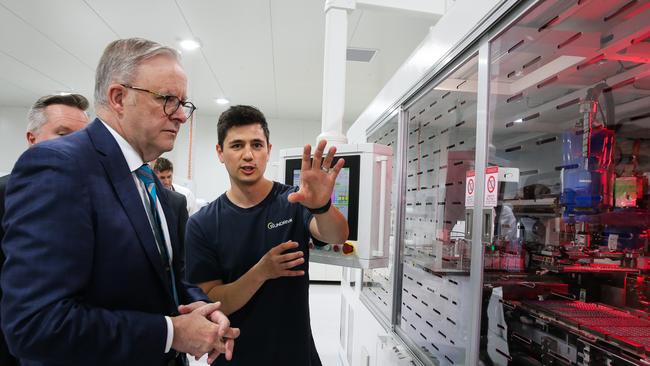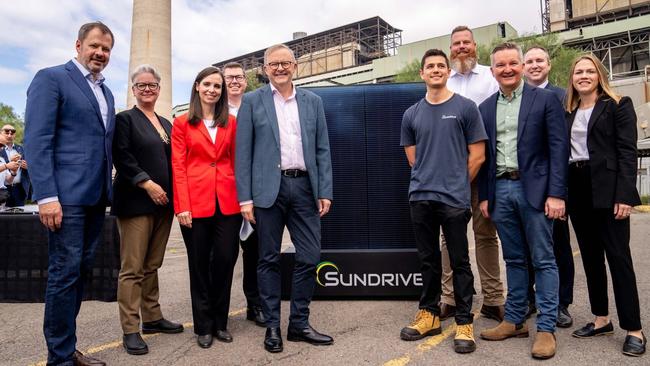
Minister for Climate Change and Energy Chris Bowen has seemed oblivious for months to the downturn in EV sales in North America and Europe, discussed several times in this column.
Now, Anthony Albanese looks out of touch as he seeks to emulate in miniature US President Joe Biden’s Inflation Reduction Act of 2022.
The misnamed IRA is in fact just old-fashioned industry policy designed to channel taxpayer dollars into industries favoured by the Democrats.
It’s been problematic, pumping money into projects often not justified by economic efficiency. And its $US1.2 trillion ($1.87 trillion) climate project stimulus and $US400bn in loans are keeping a floor under inflation. Federal Reserve chair Jerome Powell warned only last week that the Fed may not be able to meet rate cut expectations this year because of “sticky” inflation.
The International Monetary Fund was explicit on Wednesday.
Its latest World Economic Outlook warned government-led industry policy is damaging medium-term global growth trends.
Yet just as Bowen doubled down on support for EVs in the months after Ford US began winding back IRA-inspired investment in EVs because buyers don’t want them, Albanese chimed in on April 11 with a speech to the Queensland Press Club promising his government was going to follow the IRA with legislation mid-year to be called the Future Made In Australia Act.
At least the mainstream media’s political and economic journalists showed a bit more scepticism than some of the motoring writers at the same businesses, who still seem blissfully unaware of the downturn in EV sales in Europe and the US.
Analysing Albo’s planned subsidies for green manufacturing, some journalists are old enough to remember the debacles of the late 1980s and early 1990s when the Labor governments of Victoria, South Australia and Western Australia thought picking winners was a great strategy. That all came to a screeching halt with the financial collapses of Tricontinental, the merchant banking arm of the State Bank of Victoria, and Pyramid Building Society, the State Bank of South Australia and WA Inc.

Even ministers in the economically successful Hawke and Keating governments were often heard lamenting Australia’s reliance on mining and tourism.
Surely we could make semiconductors here and be more than a mine and a beach, some said.
That was only 15 years before the greatest mining boom in Australia’s history, driven by the industrial transformations of China, India and Southeast Asia. It turns out, Australia’s comparative advantage in mining and tourism has served the nation well.
Now Albo thinks we need to make solar panels here, even though their price has collapsed from $1 a watt to 11c.
On Thursday, March 28 he announced a billion-dollar support package for the Solar SunShot project to make solar cells in the Hunter Valley at the site of the now closed Liddell power plant.
The project will be a joint venture by Liddell owner AGL and solar start-up SunDrive, with funding from the government-owned Australian Renewable Energy Agency.
Reporters with long memories may recall Albanese was infrastructure minister in the first Rudd and Gillard governments.
Indeed, he was in cabinet in November 2008 when one of the world’s then largest solar cell manufacturers collapsed here under the pressure of high wages.
Rudd refused to offer support to keep the business open.
BP Solar at Homebush in Sydney was set up to power the site of the Sydney Olympics, and early in the century was one of the largest solar cell manufacturers in the world.
One of the young stars of that pioneering Australian solar era, Shi Zhengrong, completed his PhD under Sydney solar researcher Professor Martin Green, who had mentored many of the executives who ran British-owned BP Solar.
The young Shi Zhengrong left Australia for China in 2000 to set up Suntech there and become for a time China’s richest man.

China had a clear comparative advantage over the Sydney business in lower wage costs.
The ABC in 2021 quoted Dr Shi saying: “I’ve been asked many times why did I start the business in China, not Australia? When I was in Australia, I was really just a student and a scholar … Also, the cost of labour in Australia in fairly high.”
And getting much higher now thanks to the wage reforms of Albanese’s Employment and Workplace Relations Minister, Tony Burke.
This all goes to the heart of what governments can do to help businesses succeed – ensure cheap power, a flexible labour market, efficient training and a competitive tax regime.
The Australian Financial Review’s editorial on April 11 got to the heart of the matter: “Subsidising industries in which Australia does not have a long term competitive advantage, such as building solar panels in a market flooded with cheap Chinese product, diverts workers and capital away from industries where they will generate higher value.”
Economists and business leaders were concerned late last year when Treasurer Jim Chalmers announced former Grattan Institute CEO Danielle Wood would take over the Productivity Commission.
The PC has been a hard-headed driver of reform policy, while Grattan is perceived as softer and more left-leaning.
But Wood was bang on in her assessment of Albanese’s “new protectionism”.
She warned the Future Made in Australia Act risked creating businesses that would always need to rely on subsidies.
All of Wood’s predecessors as chair of the PC followed up with similar warnings.
Albanese’s real motivation is political. He wants green boondoggles for communities, often in Labor federal electorates, that are to lose jobs when coal-fired power stations close.
And his government is confronting a private investment shortfall in green power generation needed to meet Labor’s 2030 emissions reduction target of 43 per cent on 2005 levels, and a renewables penetration target of 82 per cent.
Perhaps the most interesting recent media response to the green challenges Australia faces has come from the trade union and industry superannuation-aligned The New Daily.
ABC finance presenter Alan Kohler wrote on the Daily website on April 15 that “climate change is a cost, not benefit, and saying we can win is a lie”.
Kohler pointed to the cost problems of so-called green hydrogen, which does not really exist yet.
He also cited research published here by Net Zero Australia, putting the cost of net zero here by 2060 at $9 trillion.
Kohler added: “I understand the political and business impulse to talk it up and tell us that everything’s going to be terrific, with a future made in Australia etc, because if they told us the truth we’d all line up at a bridge or a tall building and jump off.”
It’s worse for climate true believers such as Kohler.
The evidence is Biden’s Inflation Reduction Act has actually stimulated US oil and gas production and exports.
While the first Productivity Commissioner chair, Gary Banks, was criticised by the PM late last week as a “flat earther”, Banks nailed the flaws in Albo’s policies on energy, industrial relations and picking winners: “Just declaring that an issue is in the national interest does not make it so.”







Some politicians seem unaware of the overseas failures of policies they support for Australia.